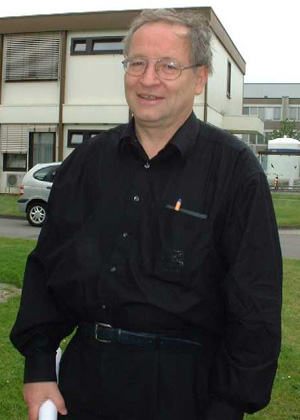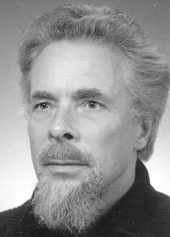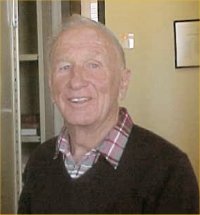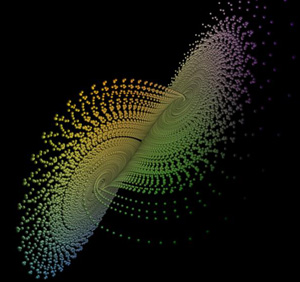The butterfly effect is more than a cheap chat-up line for fictional chaoticians running from dinosaurs. The science of which the flapping of iridescent wings in Beijing might startle a Florida hurricane into action has finally come of age. Chaos theory is now part of that most ubiquitous of household appliances – the microwave oven.
It came as quite a shock to buy a new microwave oven and find that it had a chaos defrost setting, say husband and wife team mathematician Jaroslav Stark and reproductive biologist Kate Hardy of Imperial College London in a recent issue of the journal Science. The chaos setting uses chaos theory, or what researchers these days prefer to call non-linear dynamics to produce an irregular heating sequence that is supposed to reduce the defrost time by 60%; leading to even faster fast food one might presume.

Peter Grassberger
Non-linear dynamics has actually been around a lot longer than the term popularised by the likes of James Gleick in his seminal book – Chaos. Scientists in the nineteenth century recognised the unpredictability of many natural and indeed unnatural processes. Jules Henri Poincaré, for instance, appeared to be aware of the possibility of chaos, but said it was just too awful to think about. This indeterminacy meant that they could not produce a nice straight-line plot of any two parameters for such a changing system. Hence non-linear dynamics.
New insight into the nature of non-linear systems in the 1960s provided a new impetus for research. In particular, the work of Edward N. Lorenz (Professor Emeritus at Massachusetts Institute of Technology) on that archetypal chaotic system the Earth’s atmosphere showed how even simple models could exhibit extremely complex behaviour.

Floris Takens
It was Lorenz who coined the idea of the butterfly effect (although not necessarily the phrase itself) and he certainly gave his name to the eponymous attractor. The basic idea of a butterfly affecting the weather half-way round the world is somewhat misleading since the atmosphere is also subject to a variety of random effects which would probably wash out such a tiny perturbation, explains Stark, I can, however, see that it is such an appealing concept that it makes sense to use it in talking about chaos. He admits that few serious researchers use the term.

Edward Lorenz
Predicting the behaviour of this system was never likely to be easy. The advent of more and more powerful computational techniques and papers by Floris Takens (Emeritus Professor of mathematics at the University of Groningen, The Netherlands) and Peter Grassberger (Jülich Research Centre) and Itamar Procaccia (Weizmann Institute of Science, Israel) in the 1980s provided for a data-driven approach. Takens demonstrated that data produced by a system relate directly to its underlying dynamics. Grassberger and Procaccia in their turn found a way to measure complexity. But, even these new developments could not offer an understanding of the complex behaviour that can emerge from seemingly simple processes and systems that behave chaotically.

The strangeness of chaos is embedded in the Lorenz attractor (Credit: Jean-Francois Colonna, CMAP, Ecole Polytechnique, France)
Nevertheless, phenomena once dismissed as nothing more than random fluctuations or experimental error have emerged to reveal themselves as manifestations of subtle and fundamental properties of almost every system researchers care to consider, from the dripping of a tap to the defrosting of a pizza. Solving chaotic systems using modern computers is not much of a problem (at least approximately), understanding the solutions is the real difficulty, Stark told Spotlight.

Can the beat of a butterfly’s wing cause a hurricane half way across the world?
Now, Stark and Hardy are arguing that the kind of progress in non-linear dynamics that is leading to practical applications in medicine and engineering, such as that microwave chaos setting, modern spacecraft guidance, and blood flow, has only become possible recently because a change in the field has united the different approaches – the empirical and the hypothetical. Neither approach provides the complete picture, and only the synergy between them is likely to lead to solutions in the real problems in an increasingly complex world, explain Stark and Hardy.
The team cites several areas of research where the fusion of experimental and theoretical approaches, the data-driven and the model-driven methods, is leading to practical applications less trivial than a more effective microwave defrost setting. Modern non-linear dynamics could help us understand the emergence of epidemics from SARS to foot and mouth disease. The theory can allow us to study the signalling networks of cells – and how genes and metabolic interactions control the cell’s behaviour as a whole, rather than having to resort to the more conventional deconstruction approaches.
Further reading
Science, 2003, 301(5637), 1192
http://www.sciencemag.org/cgi/content/full/301/5637/1192
Jurassic Park
http://sfy.ru/sfy.html?script=jurassic_park
Kate Hardy
http://www1.imperial.ac.uk/medicine/people/k.hardy/
James Gleick
http://www.around.com/
Gleick’s work, “Chaos”
http://www.amazon.co.uk/exec/obidos/ASIN/0749386061/davidbradleyse0e
Butterfly effect?
http://www.cmp.caltech.edu/~mcc/chaos_new/Lorenz.html
Floris Takens
http://www.math.rug.nl/~takens/
Peter Grassberger
http://www.fz-juelich.de/nic/Forschungsgruppen/Komplexe_Systeme/members/grass/grass.html
Itamar Procaccia
http://www.weizmann.ac.il/chemphys/cfprocac/home.html
Suggested searches
chaos theory